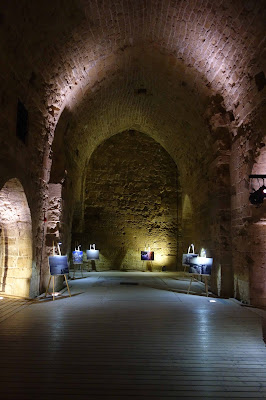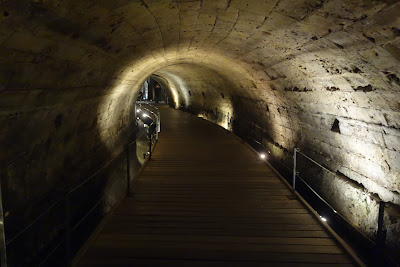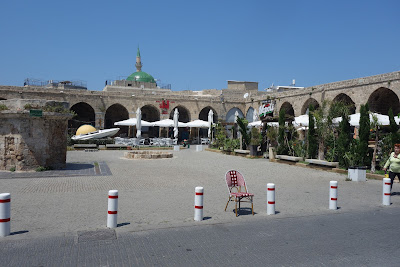HAIFA
A brief overview of the port city of Haifa on our way to
Acre included a photo stop at Mt. Carmel and a breathtaking view of Haifa
Bay. The golden dome of Haifa's Baha'i
Shrine is pictured in its gardens. The
Baha’i faith numbers over 5 million people worldwide and holds this site as
sacred.
The current town of Nazareth is located about 20 miles away
from here. Strangely, Nazareth did not
exist as a town until about 80 AD and did not flourish as a city until about
300 AD.
Given this, some scholars believe Mt. Carmel was the original home of a few hundred married Essenes, or the Nazoreans of Mt. Carmel as they were known. It is reported to have been a cooperative family village where “Jesus, the Nazorean”, as Paul referred to him, was likely to have been raised. Haifa, including Mt. Carmel, is now about 300,000 people, many of whom are Christians and Muslims.
Given this, some scholars believe Mt. Carmel was the original home of a few hundred married Essenes, or the Nazoreans of Mt. Carmel as they were known. It is reported to have been a cooperative family village where “Jesus, the Nazorean”, as Paul referred to him, was likely to have been raised. Haifa, including Mt. Carmel, is now about 300,000 people, many of whom are Christians and Muslims.
ACRE (aka AKKO)
Situated on the northernmost point of Haifa Bay, is the
amazing UNESCO World Heritage Site of Acre (Akko). I tend to be a bit of a Knights Templar junkie,
given all of the gothic cathedrals throughout Europe either financed by or
built by the order, so this excursion was particularly interesting to me.
It was Baldwin I who led the First Crusade to the Holy Land, captured Jerusalem from the Saracens (Muslims) and rescued Christ’s sepulcher from the “infidels” in 1099 AD.
Years later the Poor Knights of Christ and the Temple of Solomon (aka Knights Templar), the Knights Hospitallers, the Knights of St. John and the Teutonic Knights found themselves in a bit of a mess and had to escape to Cypress through Acre in 1291 AD. But in the many years before their escape, Acre was the Knights Templar’s main three-walled-moated-fortress for protecting arriving European pilgrims.
It was here they built three sea ports for Genoa, Venice and Pisa and created a vibrant merchant enterprise on top of what
lay beneath.
The knights’ underground city,
discovered by accident and opened to the public at various time during in the 1990’s,
is a staggering find. Rubble was cleared from beneath the city
streets to reveal a series of vaulted rooms called the Crusader Halls, which lead
to the Refectory (dining hall ... table and chairs are not original).
Part of this underground city was known
as the Hospitaller Quarter because it was there that the knights received their
medical care.
Also referred to as the Crypt, it is a
true representation of Crusader architecture. Near to the Crypt is a stairway
which leads to a long underground passage that is thought to be an escape
tunnel that was built by the Crusaders in order to reach the port during
attacks by Muslim forces.
Returning to the surface was a welcomed relief, after the narrow
passages and low ceilings of the tunnels, and put us the middle of Acre's long
and colorful Ottoman period.
P.S. As a piece of
trivia … the country we now refer to as Israel was actually two kingdoms back
in the day - Israel to the north and Judah to the south. King David united them and his son, King Solomon,
was able to keep the kingdom together during his reign. Eventually their belief systems and cultural
differences caused them to once again separate. Judah was originally settled by
nomadic Semites from today’s Jordan. Israel
was originally settled by escaping Egyptian slaves from the Exodus. [In this regard, there’s a whole biblical
thing regarding two of Jacob’s (aka Israel) sons, Joseph (mother: Rachel) and
Judah (mother: Leah), but I’ll save that for another time.] For now, I think it’s interesting to note that
some hold an esoteric meaning to the name "Israel" to have been derived from: IS (from the Egyptian goddess, Isis), RA (from
the Egyptian Sun God, Ra), and EL (from the northern kingdom’s god, Elohim).
Later, Bill.








No comments:
Post a Comment